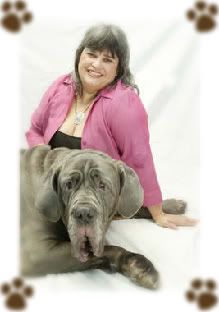I just got back my marked module for 'Application of Theory' for my Advanced Diploma in Canine Behavioural Management. I thought it'd be interesting to post it here (including the tutor's comments) as an example of my level of study at the moment and also as it encapsulates my theory on 'The 'D' Word'.
"Module question 10.10 - What are your views on human and dog hierarchy? Do you think dogs that are allowed to sleep on beds or other furniture, or are fed before the family, or that rush through doorways are likely to become aggressive? Justify your opinions.
I have fairly open and flexible views about human and dog hierarchy.
I do not believe that dogs that are allowed to sleep on beds or other furniture, or are fed before the family, or that rush through doorways are ‘likely’ to become aggressive. The reason for this is because in my home, all the dogs that have ever become part of our family throughout my entire life have done all of the above and I have never owned a dog that has ‘become’ aggressive.
However, I believe that if I were to regularly approach a sleeping dog that was on my bed or on the sofa and become agitated or aggressive myself in order to move them, or I reacted to a dog rushing out of the doorway first by hitting them or losing my temper, I would probably initiate some aggressive response, probably on a predictable basis and my dog would ‘become’ aggressive. Tutor Comment: yes, this is quite likely.
The word ‘Dominance’ when applied to dogs has become synonymous with conflict and this is very unfortunate. I am dominant over my dogs, and my children (grown up as they are now!) in most situations but this does not mean I am forceful or adversarial with them. Dominant behaviour can be calm, peaceful and gentle. As an example if my dog is sitting on a place in the sofa where I want to sit (usually in the best place for watching the TV) I will gently and calmly give the dog a ‘Move’ command and then proceed to sit down, whether they have moved or not. On the first few occasions they didn’t move, I calmly sat down so close to them it that became uncomfortable for them to stay there so they have subsequently made the decision to relinquish that spot whenever they hear the ‘Move’ command – and often before hearing it. The reward for this is that if they give me enough room, they will get to lie curled into my body for warmth and close social contact and even have their head stroked! Tutor Comment: this is a good example of how you can be ‘the boss’ without aggression and force.
In wolves, aggression does NOT equal dominance. In a two-year study on a wild population of wolves the following was noted:
“…involvement in aggressive and agonistic encounters did not show a strong relationship with rank order in either 1999 or 2000.” (Sands, et al., 2004)
Even David Mech himself has discounted his original theories from thirty years ago where ‘Alpha’ males and females fought for dominant positions in the pack. He now believes that this is achieved much more peacefully, by “…merely mating with a member of the opposite sex, producing a bunch of offspring which are the rest of the pack.” (Mech, 2008)
To specify this reasoning in human / dog relationships O’Heare (O'Heare, 2003) questions the use of the term ‘dominance’ when describing aggressive behaviour:
“Why not simply say that a particular dog is intolerant of being controlled or that he has a relatively low threshold for aggression? The dominance alternative is to postulate that the dog believes he is dominant in the relationship.”
In my professional work if owners have already allowed some ‘negotiation’ to take place and dogs are standing their ground and defending their resource successfully in the form of growling or snapping, I will still advocate peaceful, gentle, calm dominance in the form of a houseline of about 3-4ft attached to the dog’s collar or harness so that the owner can give a gentle but firm command (not a request!) and then enforce it by using the houseline to move the dog. As long as there is a reward for the dog for relinquishing their ‘resource’; a ‘point’ to the exercise from the dog’s point of view, I have found that peaceful resolution can be easily achieved.
Peaceful co-existence must surely be the goal of all social groups, whether they consist of conspecifics or not. While linear hierarchy may be necessary at times to sustain order, I believe that this is best achieved through calm, cooperation and negotiation and a more ‘fluidic’ state of hierarchy rather than a strict linear one at all times. Tutor Comment: well done, this is an excellent answer.
References
Mech, L David. 2008. "Alpha Wolf"? YouTube.com. [Online] 15 February 2008. [Cited: 11 October 2009.] http://www.youtube.com/watch?v=tNtFgdwTsbU.
O'Heare, James. 2003. Dominance Theory and Dogs. 1. Ottawa : DogPsych, 2003. p. 35. Vol. 1.
Sands, Jennifer and Creel, Scott. 2004. Social Dominance, Aggression and Faecal Glucocorticoid Levels in a Wild Population of Wolves, Canis Lupus. Animal Behaviour. 2004, Vol. 67, 3, pp. 387-396.







